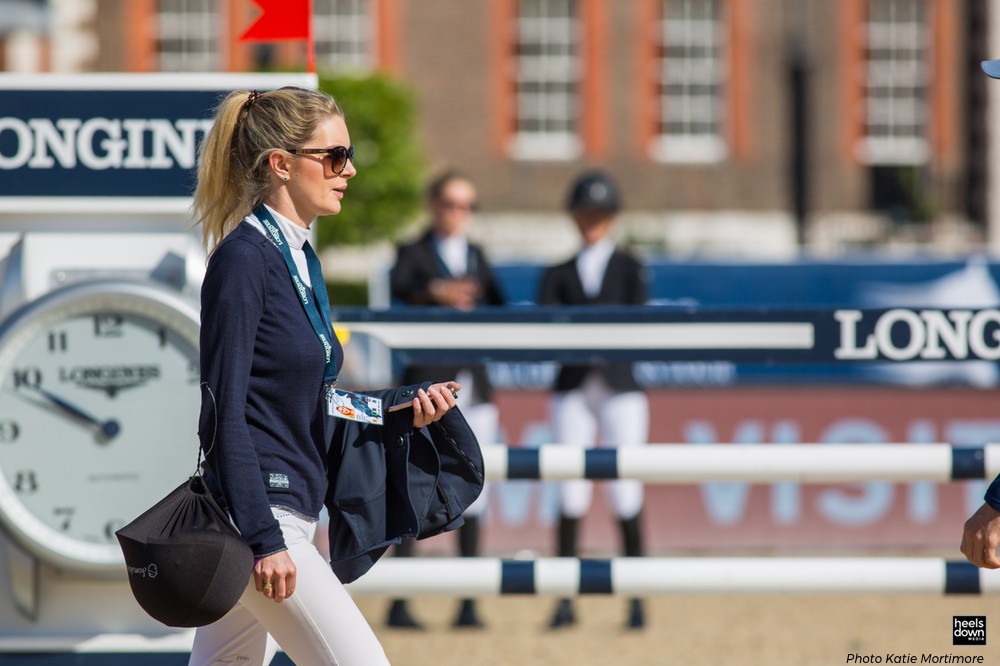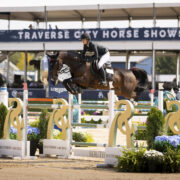Hypnosis To Improve Your Riding? Yes, It’s A Thing

By Carolyn Mahon
As athletes, we will all face mental and physical challenges along our journey.
Perhaps you and your horse had a great run, but have plateaued, and are not moving in the direction you would like. Or you had an incident that has left you fearful if that accident may happen again. Or pre-show jitters often get the best of you. Hypnosis can help.
Yes, I said hypnosis.
Hypnosis is a complementary treatment that can be effective in a number of scenarios. It has been used for weight loss, addiction, insomnia, and building self-esteem. Frequently misunderstood, hypnosis is often overlooked as a tool that can be used to reach goals, overcome obstacles and to reframe unwanted habits.
When you heard the word “hypnosis,” did you picture someone swinging a pocket watch and chanting, “You are getting sleepy…”? Or did you envision someone on stage making a volunteer from the audience quack like a duck? While stage hypnosis certainly does exist and can be quite entertaining, it is only one form of hypnosis practice.
Another type, which could be beneficial to equestrians, is goal oriented or therapeutic hypnosis. In this type of hypnosis, the client has a desire to create or change something in his or her life. Working with a trained and certified hypnotist and using the power of their own mind, can help them achieve that goal.
“We train the brain to have a different response to the trigger of preparing to enter the show ring.”
Hypnosis is a process which “unlocks” the unlimited power of the subconscious mind to create positive, lasting change. The subconscious mind is the control center of the brain. It does most of the thinking, makes decisions, and takes care of the things we do automatically, such as breathing and blinking. It registers body sensations, emotional feelings, and is the storehouse for memories. The conscious mind is more critical and inhibited. It filters information and analyzes situations. It craves the status quo. Therefore, in order to reach the subconscious mind, we must bypass the conscious mind.
So, How Does It Work?
Hypnosis works by guiding the client into a deep state of relaxation in order to quiet and distract the conscious mind. Hypnotic sessions have four main components. Each practitioner’s style might be a little different, but the basic road map is the same.
The session typically starts with a discussion. If this is a first session, the goals will be discussed. A program will be decided upon. It is very important for both practitioner and client to be clear on what the desired outcome is. In subsequent sessions, the conversation will involve updating the practitioner on what progress has been made and what challenges, if any, have been encountered.
The hypnosis portion of the session also starts with “induction”. This is the preliminary stage of guiding the client into relaxation. It can be done by employing a few different methods. My favorite, and in my practice the most successful method is the use of guided imagery. By telling a calming and relaxing tale that engages the mind through visualization, the client begins to relax and lets go of distractions by focusing on the images being described.
The next phase is the “deepener”. At this point, more detailed scenarios are shared with the goal of bringing the client into an even deeper state of relaxation, sometimes referred to as the “trance” state.
The third phase is the suggestion portion. At this point, the subconscious mind is open, accepting, and ready to receive the suggestions that are made. The “script” or suggestions are specifically created to address the individual’s needs and goals.
Finally, there is the awakening. This is the point where the client is brought out of hypnosis. He or she will emerge feeling alert and very well rested, as though the client has just had a nice nap. The client may or may not remember the specifics of what has been said. In either case, the subconscious mind has received the suggestions.
Why Riders Benefit
There are so many situations that can be helped with this type of hypnosis. For example, let’s examine a rider who is having a very difficult time with pre-show jitters. In hypnosis, we can help the client to overcome them. During the script or suggestion portion of the session, the client can be guided through the experience of attending a show and not having those same nervous responses.
In essence, we train the brain to have a different response to the trigger of preparing to enter the show ring. By consistently visualizing and experiencing this situation in the client’s mind, a new relaxed response is created.
This works for a rider who has had a frightening experience as well. Oftentimes, the situation that created the fear is significant because it was unexpected. Intellectually, the rider might know that it is unlikely that the same situation will happen again, but the fear response is so great that it takes over. In hypnosis, we can recreate the initial sensitizing event and give it a different outcome.
” Hypnosis is a process which ‘unlocks’ the unlimited power of the subconscious mind to create positive, lasting change.”
Hypnosis is great for building confidence and overcoming psychological blocks as well. The subconscious mind does not differentiate between actual memories and created ones. Therefore, it can be very effective to give the subconscious mind a new “memory” with positive associations and outcomes upon which to draw.
The possibilities are vast and varied. Hypnosis can be used to create positive and seemingly effortless change. It is important to note that as effective as it is, hypnosis is not a magic wand. The success or failure of any hypnosis program depends on the client’s commitment to making the change. Hypnosis is not mind control and a client cannot be hypnotized to do anything he or she does not want to do. In order for it to work, clients must truly desire to make the change and must believe in their own power to make it happen and to achieve their goal.
The mind has limitless power. It is up to us to harness that power and use it for our greatest good. When we do, we will see and feel the benefits of taking care of ourselves from the inside out — and our horses will too.



